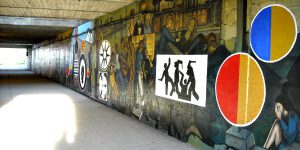In the earlier decades of the twentieth century, Lorado Taft may have been Chicago’s most famous artist. His was a name I’d never heard before, but after a little research I realized I’d seen his sculptures all over town. I first saw his “Fountain of The Great Lakes” outside the Art Institute in high school and discovered his two Graceland Cemetery sculptures, one a crusader and another titled “Eternal Silence”, back in October. Beyond that, Taft’s pieces can be found in places like the University of Illinois (his alma mater), over in Oregon, Illinois, and at Union Station in Washington DC. Taft also contributed to the World’s Columbian Exposition in 1893 by creating plaster sculptures along the Midway Plaisance between Washington Park and Jackson Park.
Taft began work on “Fountain of Time” in 1908 after being inspired by a couplet by Austin Dobsen: Time goes, you say? Ah no, alas, time stays. We go. He considered the sculpture something of a magnum opus and it took him and his team of sculptors 14 years to complete.
Upon moving to Hyde Park in September, I was told I had to check out “Fountain of Time,” but constantly put it off. Finally, a few weeks ago, I made it over to its location near 60th and Cottage Grove. Resting at the borders of Hyde Park, Woodlawn, and Washington Park, the sculpture is massive. At 130 feet wide, it is the largest sculpture on a single base in the United States. Still, despite its size, it is packed with a stunning variety of human experience and emotion.
Engraved before the sculpture are Taft’s comments on his reaction to Dobsen’s couplet. They read, “The words brought before me a picture. I saw the mighty crag-like figure of Time leaning upon his staff, his chin upon his hand, and watching the endless march of humanity.” In “Fountain of Time” Taft makes that image a reality. The giant, looming sculpture of Father Time faces west towards the numerous human figures, all trudging southward.
The faces and bodies of the figures are so expressive partially because they are so big. Each is rendered larger than life and sculpted with a sharp attention to detail. Whether jubilant, somber, or anguished, they never make eye contact with each other. Lovers, children, a funeral procession, even a soldier on horseback march on, unable to resist the flow of time. Standing before the procession, it was impossible not to be reminded of my own mortality.
In 1936, Lorado Taft himself became a victim of time, but through this and his other sculptures his legacy lives on. He once wrote, “One thing that separates us from our brother animals is the fact that we can send messages down through the generations. We can send greetings to a world unborn. The means by which this is done is art. Through poetry and painting and sculpture, life begins to explain itself.” Taking in his sculpture 89 years after its completion, his message definitely rings true.
This is the final article in a five part series concerning public art in Hyde Park. The other articles can be found here.




